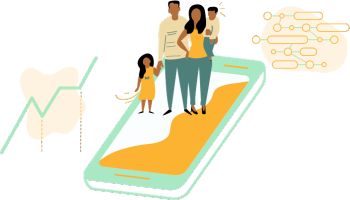What is Community Finance?
Faced with financial exclusion, people living with low-incomes bank on each other, engaging in peer-to-peer community finance.
Community finance is lending, borrowing, and resource pooling between friends, family, neighbors, and co-workers in social networks. Community finance is an everyday part of life for people living with low-incomes, extending beyond the popularized Rotating Savings and Credit Associations (ROSCAs).
For many this is not just a way of getting by, it is part of their culture, how they get ahead and support their communities.
Community finance offers several advantages
Giving Credit is built on behavioral insights that reveal the benefits and challenges of community finance.
Community Finance FAQs
-
Community finance is informal lending, borrowing, and resource pooling between friends, family, neighbors, and co-workers in social networks. Community finance is an everyday part of life for people living with low-incomes, extending beyond the popularized Rotating Savings and Credit Associations (ROSCAs). For many this is not just a way of getting by, it is part of their culture and how they support their communities.
-
Access to financial services is central to well-being and human dignity. Faced with financial exclusion, people turn to their social networks to meet their financial needs. Community finance is especially vital in low-income communities of color.
-
Financial exclusion occurs when people do not have access to affordable financial products that meet their needs.
Forty-five million people in the United States do not have credit scores.
Nineteen million households are underbanked.
Payday lenders extract $9 billion annually from low-income communities, charging interest rates as high as 600%.
-
Like mainstream financial products, people engage in community finance for a number of reasons, including meeting their basic needs, starting businesses, and everything in between. Half of renters that lose income and fall behind on rent borrow from friends and family.
-
Interviews suggest the average loan size is a few hundred dollars, in line with the average payday loan of about $300. In some cases people borrow $1,000 or more. Relatively larger loans are more likely to be pooled from multiple lenders.
-
Interviews with low-to-moderate income households suggest most people lend or borrow (or both) a few times a year. In some cases, especially in relatively lower-income networks, informal lending and borrowing can be as frequent as several times per month.
-
Interviews reveal that people are far more reluctant to turn to Alternative Financial Services like payday lenders than they are to turn to their networks. When people cannot borrow from their networks (or think they can’t borrow) only then do they reluctantly turn to predatory financial services.
-
Generally informal lenders do not charge interest. Unlike mainstream finance, community finance occurs between people in bonded social networks. Reasons people make informal no-interest loans include:
Prioritizing the well-being of the borrower, such as helping a friend avoid eviction.
Lending today because you might need a loan in the future.
Getting a “warm glow” from doing a good deed, the same benefit people get from donating to charity.
It’s important to note these reasons are not mutually exclusive. People often lend to people they care about, get the “warm glow”, and hope to receive reciprocated credit sometime in the future.
-
Yes! In fact, 26M adults borrow informally every year. While having a credit card at middle and high-incomes reduces reliance on peer borrowing, having a credit card does not reduce peer-borrowing for lower-income households
-
Community-lenders, often low-to-moderate income themselves, make unsecured loans to kin, friends, and neighbors at risk to their personal financial well-being. This risk is especially acute for Black and Latinx households who tend to have materially poorer networks than Whites. About a tenth of the Black-White racial wealth gap is attributable to Blacks providing financial assistance to lower-income members of their social networks.




